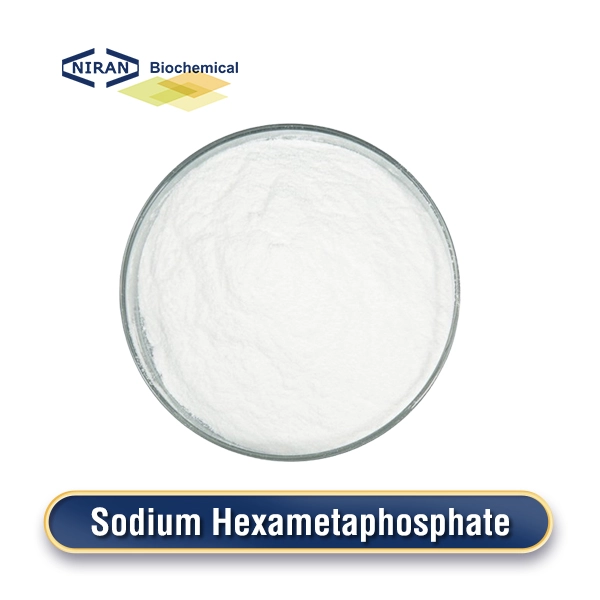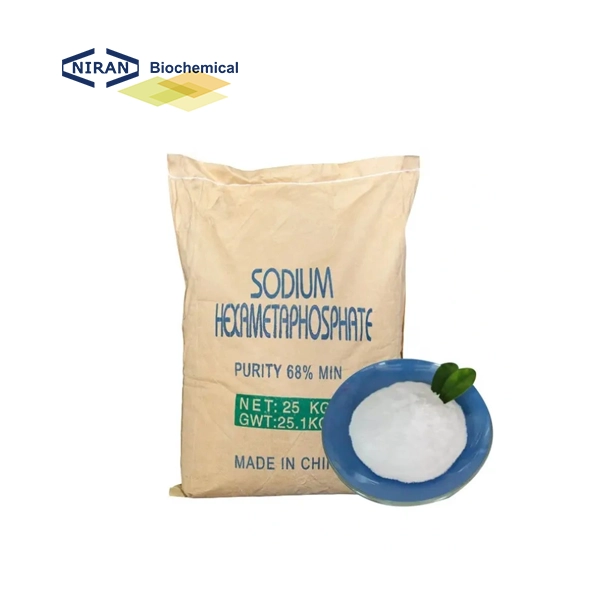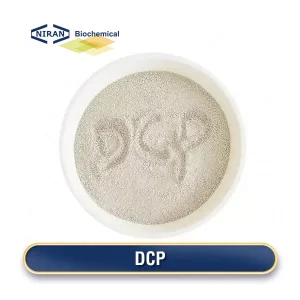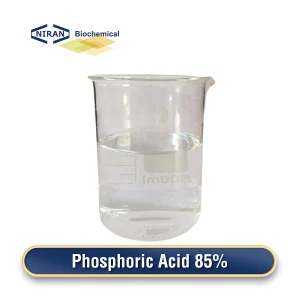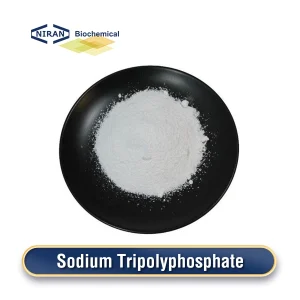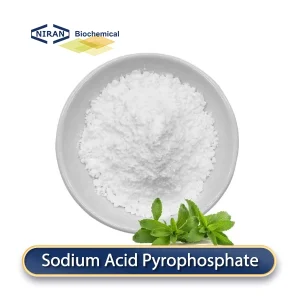Niran Biochemical
YOUR RELIABLE FOOD INGREDIENTS
Send Inquiry
Home » Products » Phosphates » SHMP—Sodium Hexametaphosphate
SHMP—Sodium Hexametaphosphate
- CAS: 10124-56-8
- Chemical Formula: (NaPO3)6
- Certification: KOSHER, ISO, HALAL, FSSC22000, BRC, etc.
- Standard: BP/USP/FCC
- MOQ: 1000KG
- Shelf Life: 2 Years
Inquire Product
Product Description
Sodium Hexametaphosphate Preparation Methods
The main preparation methods of sodium hexametaphosphate in China include thermal polymerization and phosphoric acid method. The thermal polymerization method generates sodium hexametaphosphate by mixing sodium dihydrogen phosphate and disodium hydrogen phosphate in proportion and heating them to 300-500℃ for polymerization reaction; the phosphoric acid method generates sodium hexametaphosphate by neutralizing phosphoric acid and sodium carbonate to generate a sodium phosphate salt mixture, and then heating and polymerizing to obtain sodium hexametaphosphate.
At present, thermal polymerization is the mainstream method for preparing sodium hexametaphosphate in China. This method has mature technology, high production efficiency and high product purity.
Related parameters:
| Items | Standards |
| Solubility | Very soluble in water |
| Test for sodium /phosphate | Passes test |
| PH (1 % solution) | 5.8-6.5 |
| Assay(as P2O5 content ) | 68% Min |
| Flouride (expressed as fluorine) | 10 ppm Max |
| Asenic | 1 ppm Max |
| Water insoluble matter | 0.05% Max |
| Heavy Metals(as Pb) | 10 ppm Max |
| Lead | 1 ppm Max |
| Mercury (Hg) | 0.2 ppm Max |
| Cadmium (Cd) | 1 ppm Max |
| Fe | 90 ppm Max |
| Loss on ignition | 1% Max |
| Bulk density | 900g/l~1200g/l |
Recommended dosage:
| Food Name | Maximum usage(g/kg) |
| Bread | 2 g/kg |
| Cake | 1.5 g/kg |
| Yogurt | 0.7 g/kg |
| Cheese | 1 g/kg |
| Dairy drinks | 1 g/kg |
| Fruit drinks | 0.5 g/kg |
| Sports drinks | 0.7 g/kg |
| Canned food | 1 g/kg |
| Sauces and condiments | 1 g/kg |
| Candy | 1.5 g/kg |
| Chocolate | 1 g/kg |
| Meat products (such as sausages, ham) | 1.5 g/kg |
| Nutritional supplements | 1 g/kg |
Sodium Hexametaphosphate has a wide range of uses
1. Improve color, flavor and aroma
Sodium hexametaphosphate is mainly used to improve the color, flavor and aroma of food. In foods such as meat products, fish sausages and ham, sodium hexametaphosphate can improve the water holding and binding properties of the product, thereby helping to maintain the color, taste and flavor of the food.
2. Prevent fat oxidation
Fat oxidation can cause food to deteriorate, affecting the taste and shelf life. The mechanism of action of sodium hexametaphosphate is to stabilize fat molecules through its antioxidant properties, thereby extending the shelf life of the product.
3. Improve water holding capacity
Sodium hexametaphosphate is mainly used in the food industry to improve the water holding capacity of food. This property is particularly suitable for meat products such as fish sausages and ham because it helps prevent water loss, thereby maintaining the taste and texture of the food.
4. Stabilizer
Sodium hexametaphosphate is mainly used as a food stabilizer. This substance is used in canned food, fruit juice drinks, dairy products and soy products to prevent water loss and maintain the stability of food structure.
User asked question:
Q: What is the role of sodium hexametaphosphate in laundry detergent?
A: Sodium hexametaphosphate mainly acts as a water softener and dispersant in laundry detergent. It prevents the formation of precipitates by chelating calcium and magnesium ions in water, softens the water quality, and disperses dirt to prevent its redeposition, thereby improving the decontamination effect and overall performance of the detergent, especially under hard water conditions.
Q: What is the market price of food-grade sodium hexametaphosphate at home and abroad?
A: In China, the price is approximately RMB 10,000-13,000 per ton. This range reflects domestic production costs and demand from many industries. The demand is driven by the growth in processed food consumption and industrial applications.
In international markets, prices can be higher due to transportation costs and import duties. In the United States and Europe, prices range from $1,800 to $2,400 per ton. North America remains a significant market due to the strong presence of end-use industries like food processing and water treatment.
The Asia-Pacific region is seeing the fastest growth, with countries like India, China, and Southeast Asian nations experiencing increased demand due to rising disposable incomes and urbanization, which boosts the need for packaged foods and beverages.

